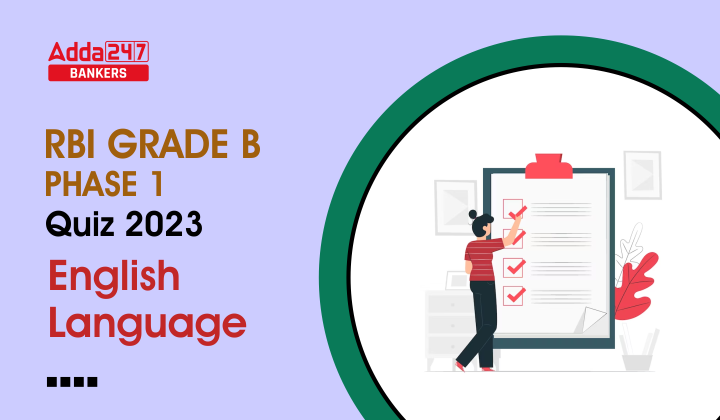Directions (1-5): Rearrange the following five sentence (A), (B), (C), (D) and (E) in the proper sequence to form a meaningful paragraph and then answer the questions given below.
(A) He traced the lack of creativity to an education system that rewarded studiousness over independent thought.
(B) Building global IT giants may have more to do with an appetite for growing a business rather than anything else, Mr. Wozniak’s assessment of India’s education system is sharp.
(C) For good measure he likened this to the culture of Singapore, but here he may have missed a trick.
(D) He also managed an anthropological take when he identified the ‘MBA and the Merc’ as the mark of success in India’s corporate world.
(E) The per capita income of Singaporeans is quite close to that of Americans. And that country has achieved much of what it set out to do when it struck off on its own, which was to turn a swampy colonial port into a prosperous city state proudly independent of world powers.
Q1. Which among the following is the SECOND statement of the coherent paragraph after rearrangement?
(a) A
(b) B
(c) C
(d) D
(e) E
Q2. Which among the following is the FIRST statement of the coherent paragraph after rearrangement?
(a) A
(b) B
(c) C
(d) D
(e) E
Q3. Which among the following is the LAST statement of the coherent paragraph after rearrangement?
(a) A
(b) B
(c) Cl
(d) D
(e) E
Q4. Which among the following is the FOURTH statement of the coherent paragraph after rearrangement?
(a) A
(b) B
(c) C
(d) D
(e) E
Q5. Which among the following is the THIRD statement of the coherent paragraph after rearrangement?
(a) A
(b) B
(c) C
(d) D
(e) E
Directions (6-10): Rearrange the following five sentence (A), (B), (C), (D) and (E) in the proper sequence to form a meaningful paragraph and then answer the questions given below.
(A) In fact, what’s worrying is that some of these expensive plants may end up being liquidated because lenders would resist selling them at big haircuts, fearful of being questioned by the investigative agencies.
(B) What is more important, however, is that it won’t really solve the issues faced by these plants and will, at most, help postpone the day of reckoning.
(C) Which is why union power minister RK Singh is trying to convince RBI it should provide lenders some forbearance for these assets.
(D) Whether the central bank will make exceptions for one sector is not clear.
(E) With over 40,000 MW of power plants already unviable for want of fuel or power purchase agreements (PPAs), and likely to be sold for a song if they turn into non-performing assets on banks’ books and end up in the NCLT, it is understandable the government is seriously concerned.
Q6. Which among the following statements become the FIRST sentence of the paragraph after rearrangement?
(a) A
(b) B
(c) D
(d) C
(e) E
Q7. Which among the following statements become the LAST sentence of the paragraph after rearrangement?
(a) A
(b) B
(c) D
(d) C
(e) E
Q8. Which among the following statements become the THIRD sentence of the paragraph after rearrangement?
(a) A
(b) B
(c) D
(d) C
(e) E
Q9. Which among the following statements become the SECOND sentence of the paragraph after rearrangement?
(a) A
(b) B
(c) D
(d) C
(e) E
Q10. Which among the following statements become the FOURTH sentence of the paragraph after rearrangement?
(a) A
(b) B
(c) D
(d) C
(e) E
Directions (11-15): Rearrange the following five sentences (A), (B), (C), (D) and (E) in the proper sequence to form a meaningful paragraph and then answer the questions given below.
(A) The aim of the NHPS is to cover 10 crore families with medical insurance of Rs 5 lakh per household per year.
(B) The country’s average out-of-pocket expenditure on healthcare is one of the highest globally, at 68%, and this means that of every Rs 100 spent by the public on healthcare, Rs 68 comes from their pocket.
(C)In comparison, the out-of-pocket expenditure is much lower in China, at 34%, and in the US it is 11%.
(D) With the announcement of the National Health Protection Scheme (NHPS), India has embarked on the path of universal health coverage.
(E) India, currently, has a highly inadequate social security structure, and the situation is especially dire in healthcare.
Q11. Which one among the following sentences becomes the SECOND sentence of the coherent paragraph after the rearrangement?
(a) A
(b) D
(c) B
(d) C
(e) E
Q12. Which one among the following sentences becomes the FIRST sentence of the coherent paragraph after the rearrangement?
(a) A
(b) D
(c) B
(d) C
(e) E
Q13. Choose the most appropriate sequence of the sentences to form a coherent paragraph.
(a) DAECB
(b) AEDBC
(c) EDABC
(d) DAEBC
(e) DABEC
Q14. Among the following pairs which one of them is formed with two consecutive statements after the rearrangement?
(a) A – B
(b) E – B
(c) E – C
(d) C – D
(e) D – E
Q15. Among the following sentences which one of them should consecutively follow the last sentence of the paragraph after the rearrangement?
(a) In addition, it will be important for the government to increase the spending on primary and preventive healthcare.
(b) Government needs to increase the overall spending on the healthcare sector.
(c) This concept is already there in rural areas in the form of ASHA.
(d) With the NHPS enabling financing of healthcare for a large chunk of the population, there will be a big jump in the demand for healthcare.
(e) Due to this high out-of-pocket healthcare expenditure, 7% of the population in India is pushed below poverty threshold every year.
Solutions
S1. Ans. (a)
Sol. The correct sequence of the sentences after rearrangement is BADCE. Hence, option (a) becomes the most suitable answer choice.
S2. Ans. (b)
Sol. The correct sequence of the sentences after rearrangement is BADCE. Hence, option (b) becomes the most suitable answer choice.
S3. Ans. (e)
Sol. The correct sequence of the sentences after rearrangement is BADCE. Hence, option (e) becomes the most suitable answer choice.
S4. Ans. (c)
Sol. The correct sequence of the sentences after rearrangement is BADCE. Hence, option (c) becomes the most suitable answer choice.
S5. Ans. (d)
Sol. The correct sequence of the sentences after rearrangement is BADCE. Hence, option (d) becomes the most suitable answer choice.
S6. Ans. (e)
Sol. The correct sequence of the sentence after the rearranging them to form a coherent paragraph is EACDB. Hence, option (e) is the most suitable answer choice.
S7. Ans. (b)
Sol. The correct sequence of the sentence after the rearranging them to form a coherent paragraph is EACDB. Hence, option (b) is the most suitable answer choice.
S8. Ans. (d)
Sol. The correct sequence of the sentence after the rearranging them to form a coherent paragraph is EACDB. Hence, option (d) is the most suitable answer choice.
S9. Ans. (a)
Sol. The correct sequence of the sentence after the rearranging them to form a coherent paragraph is EACDB. Hence, option (a) is the most suitable answer choice.
S10. Ans. (c)
Sol. The correct sequence of the sentence after the rearranging them to form a coherent paragraph is EACDB. Hence, option (c) is the most suitable answer choice.
S11. Ans. (a)
Sol. The correct sequence of the paragraph after the rearrangement of sentences is DAEBC. Therefore, the most suitable answer choice is option (a).
S12. Ans. (b)
Sol. The correct sequence of the paragraph after the rearrangement of sentences is DAEBC. Therefore, the most suitable answer choice is option (b).
S13. Ans. (d)
Sol. The correct sequence of the paragraph after the rearrangement of sentences is DAEBC. Therefore, the most suitable answer choice is option (d).
S14. Ans. (b)
Sol. The correct sequence of the paragraph after the rearrangement of sentences is DAEBC. Sentence (E) is describing about the healthcare situation in India which is further explained in detail in sentence (B) where the average percentage expenditure of an individual on healthcare in India is provided. Thus, sentence (B) logically and contextually follows sentence (E) after the rearrangement of sentences. Therefore, the most suitable answer choice is option (b).
S15. Ans. (e)
Sol. The correct sequence of the paragraph after the rearrangement of sentences is DAEBC. As, the last statement of the sequence is sentence (C) which is providing data for comparison of out of pocket expenditure on healthcare by the countries like China and US. Thus, the statement that follows statement (C) should be option (e) which is describing about the impact of high out of pocket expenditure on the citizens of India. All the other given options fail to logically follow the theme of the paragraph. Hence, option (e) becomes the most viable answer choice.
Click Here to Register for Bank Exams 2021 Preparation Material





 बैंक ऑफ बड़ौदा में अपरेंटिस के 2700 पदों...
बैंक ऑफ बड़ौदा में अपरेंटिस के 2700 पदों...
 Delhi Police Constable Previous Year Pap...
Delhi Police Constable Previous Year Pap...
 SSC Delhi Police Constable Admit Card 20...
SSC Delhi Police Constable Admit Card 20...








